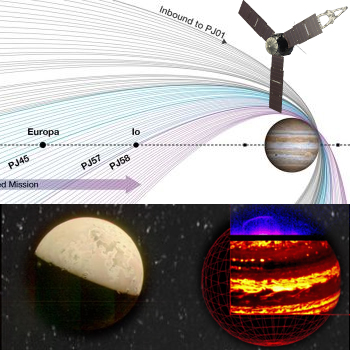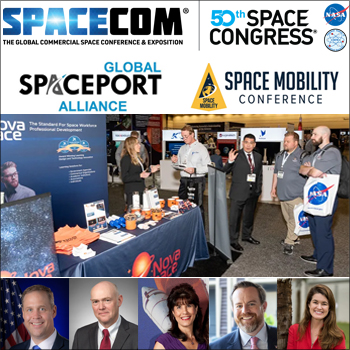Juno to Perform Final Flyby of Io, Heading into Perijove 58 and Reducing Orbital Period
On February 3, Jupiter explorer Juno is planning its 58th flyby of the great gas giant in its extended mission phase. Before the Jupiter flyby, Juno will come within 1,500 km of moon Io—the 4th largest moon and most geologically-active object in the Solar System with 400+ volcanoes. This is the last planned flyby of any one of Jupiter’s 95 moons that are officially recognized by the International Astronomical Union. Since its orbital insertion around the Jovian world on 4 July 2016, Juno has previously flown by Europa once, Ganymede twice, and Io thrice. Some of the data collected from Io observations may help reveal how its volcanic eruptions interact with Jupiter and aurorae, as well as map lava flows and investigate Io gravity field / internal structure. Perijove 58 will also reduce Juno’s orbital period around Jupiter from about 38 days to 33 days. Juno’s extended mission allows the spacecraft to continue operations into September 2025 with perijove 76 which will plunge the orbiter into the cloud tops. ESA Jupiter Icy Moons Explorer (JUICE) mission, launched April 2023, is planned to reach orbital insertion at Jupiter in July 2031, before moving to Ganymede insertion in 2034. NASA Europa Clipper mission is slated to launch this October and arrive, before JUICE, to Jupiter orbit in April 2030. (Image Credits: NASA, JPL-Caltech, SwRI) |
MONDAY☆ Jan 29 — International Space Station, ~415-km LEO: Expedition 70 seven-member crew expecting arrival of Cygnus NG-20 and <3,750 kg of cargo; Axiom 3 four-member crew may return to Earth this week after 14-day mission. ☆ Jan 29 — Tiangong Space Station, ~390-km LEO: Shenzhou-17 three-member crew share video of some of the 5,600 kg of cargo from Tianzhou 7 freighter, including Lunar New Year gifts (Year of the Dragon). Highlights… o NewSpace: Reusable Zhuque-3 rocket built by Landspace of China on track for NET 2025 inaugural launch following successful 60-sec, 350-m hop test; Sierra Space, working towards NET 2026 launch of LIFE inflatable habitat, demonstrates pressure tolerance up to 531 kPa. ☆ Solar System: Researchers at Texas A&M and Brown universities show promising results growing chickpeas in lunar stimulant; NASA working to analyze data from the 72 flights of Ingenuity Mars Helicopter; LRO LOLA instrument to be used to pinpoint location of JAXA SLIM and Intuitive Machines Nova-C following successful ping of ISRO Chandrayaan-3. ☆ Galaxy: Hubble and VLT being used to characterize uncommonly energetic FRB tracked to 7-dwarf-galaxy cluster 9,000,000,000 ly distant from Earth; Laser Interferometer Space Antenna (LISA) set to become first space-based gravitational wave detector NET 2025 following ESA mission approval. o Global: ISRO and NSIL of India in discussions to outsource production of Launch Vehicle Mark 3 to commercial sector; CNSA Chang’E-7 mission from China to be equipped with 5 Orbiter, 4 lander, 5 rover and 1 hopper science payloads; Belgium now 34th Artemis Accords signatory. ● USA: Carina Nebula ‘Cosmic Cliffs’ 7,600 ly distant imaged by JWST now featured on USPS stamps; Threshold for classification of space programs to be reduced as international space defense coordination expanding to include Italy, Japan, Norway. ● Hawai’i: State Senator Glenn Wakai (D) introduces bill to establish Aerospace and Aeronautics Development Program; Representative Kanani Souza (R) working to reopen Ellison Onizuka Space Center. |
 |
● = Terrestrial and… o = International terrestrial events
☾ = Moon activity ★ = Space and… ☆ = International space / astro events in Hawaii Standard Time unless noted. Add 10 hours to obtain UT (‘Universal Time’). |
Weekly Planet Watch – Evening Planets: Jupiter (SW), Saturn (WSW), Uranus (SW), Neptune (WSW); Morning Planets: Venus (SE).
Commercial Space Week Returns to Orlando Florida |
★ Jan 29 — SpaceX, Launch Falcon 9 / CRS2 NG-20 (Cygnus), SLC 40 Cape Canaveral SFS FL: Falcon 9 to launch next Cygnus cargo freighter dubbed S.S. Patricia “Patty” Hilliard Robertson to International Space Station. ● Jan 29 — Global Spaceport Alliance, Orlando FL: GSA Spaceport Summit; a Commercial Space Week co-located event. o Jan 29-30 — Ilan Ramon International Space Conference Committee, Israel Space Agency, Tel Aviv, Israel: 19th Ilan Ramon International Space Conference; as part of Israel annual Space Week. o Jan 29 – Feb 9 — U.N. Committee on Peaceful Uses of Outer Space (COPUOS), Vienna, Austria and Online: 61st session of the Scientific and Technical Subcommittee of COPUOS. Ongoing… ☆ Sep 6, 2023 – NET Mar — X-Ray Imaging and Spectroscopy Mission (XRISM), ~550-km LEO: XRISM undergoing 6 month check out testing phase before start of science operations to study galactic plasma. ● Sep – Feb 15 — Institute for Scientist & Engineer Educators at University of California Observatories, University of Hawaiʻi, Online: Akamai Internship Program; accepting applications from STEM undergrads for 2024 session. ● Jan 28 – Feb 1 —American Meteorological Society, Baltimore MD and Online: AMS 104th Annual Meeting. TUESDAY● Jan 30 — U.S. Space Force, Space Systems Command, Orlando FL: Space Mobility Conference; a Commercial Space Week co-located event. ● Jan 30 – Feb 1 — SpaceCom, Canaveral Council of Technical Societies, Kennedy Space Center, Boeing, USSF, et al, Orlando FL: Commercial Space Week 2024: 50th SpaceCom | Space Congress. ☆ Jan 30 — Aten Asteroid 2007 EG: Near-Earth Flyby (0.040 AU) WEDNESDAY● Jan 31 — Explorer 1 66th Observation, Nationwide USA: American Artemis Return to the Moon For Good is underway, Mars attention and planning advancing, Outer Solar System search for life ongoing, and Interstellar craft on outgoing trajectories while first USA satellite launch on this day in 1958 ‘Explorer 1’ is celebrated and remembered. |
● Jan 31 — NASA, Online: Gateway Utilization Town Hall for the International Science Community; with Participating Agencies: NASA, ESA, CSA, JAXA; 15:00 EST.
● Jan 31 — NASA, Online / Kennedy Space Center FL: NASA to Discuss Science, First Intuitive Machines Artemis Moon Flight – What’s Aboard IM-1?; 15:30 EST.
● Jan 31 — Caltech, Pasadena CA: Watson Lecture: Bethany Ehlmann Discusses the Lunar Trailblazer Mission to the Moon; 19:30 PST.
● Jan 31 — Boeing, Online: Boeing 4th Quarter 2023 financial results telecon.
THURSDAY
☆ NET Feb — ISRO, Launch LVM-3 (Launch Vehicle Mark-3) / Gaganyaan, Satish Dhawan Space Center, Sriharikota, India: India planning for 1st orbital test flight of Gaganyaan uncrewed capsule this month.
o NET Feb – NET Apr — CNSA, Online / Beijing, China: Primary selection of international payloads for Chang’E-8 mission.
☾ Feb 1 — Smart Lander for Investigating Moon (SLIM), Shioli Crater, Lunar Surface: Lunar sunset to fall on SLIM Moon craft; having landed upside down and not developed for lunar night survival, SLIM awakening for next lunar day may not be possible.
● Feb 1 — Columbia STS-107 21st Observation, Nationwide USA: Annual international conferences and events take place to further space exploration efforts in remembrance of Columbia 7 loss: Commander Richard D. Husband, Mission Specialist Laurel Clark, Payload Specialist Ilan Ramon (the ‘1st Israeli astronaut’) and Astronauts: William C. McCool, Michael P. Anderson, David M. Brown and Kalpana Chawla (the ‘1st Indian American astronaut’ and ‘1st Indian woman in space’).
☾ Feb 1 — Moon: 1.53° NE of Spica, 00:00.
☆ Feb 1 — Apollo Asteroid 2024 BY: Near-Earth Flyby (0.016 AU)
FRIDAY
☆ Feb 2 — China Rocket, China Aerospace Science and Technology, Launch Jielong-3 / Xingshidai 18-20, Bo Run Jiu Zhou Barge in Yellow Sea: Third flight of solid-fuel sea launch rocket, carrying high-resolution remote sensing satellites.
● Feb 2 — Arkisys, Los Alamito CA: Submission Due: Manufacturing In Space Survey; for a chance to win free raffle of Amazon gift card.
● Feb 2-7 — Rocky Mountain Section of the American Astronautical Society, Breckenridge CO: 46th Annual AAS Guidance, Navigation and Control Conference.
☾ Feb 2 — Moon: At last quarter, 13:19.
☆ Feb 2 — Mercury: At aphelion; 0.4667 AU from the Sun, 07:00.
☆ Feb 2 — Apollo Asteroid 2008 OS7: Near-Earth Flyby (0.019 AU)
SATURDAY
★ Feb 3 — Juno, Perijove 58 / 57th Science Flyby, Jupiter Orbit: NASA craft to perform Jupiter flyby during Perijove 58, its 58th close flyby of Jupiter and 57th science flyby with instruments turned on; will also perform 1,500-km flyby of Io, reducing orbital period from about 38 days to 33 days.
● Feb 3 — NASA, JPL, Caltech, Online / Pasadena CA: Educator Webinar – Exploring Mars with STEM Learning Resources.
SUNDAY
☾ Feb 4 — Moon: 0.59° NE of Antares, 16:00.
☆ Feb 4 — Apollo Asteroid 2019 CC5: Near-Earth Flyby (0.049 AU)

